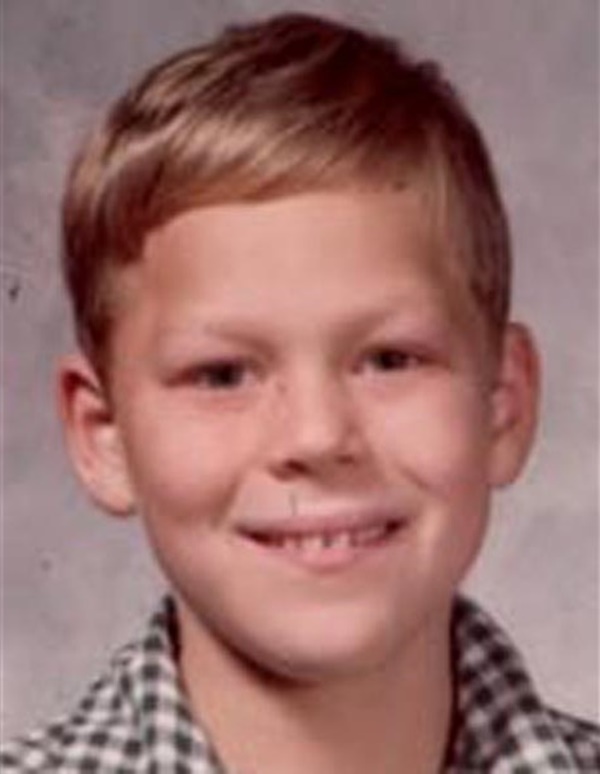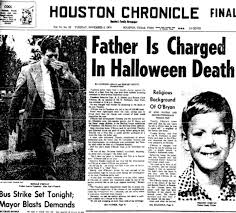O'Bryan apparently was willing to go further, passing the poisoned Pixy Stix to at least four other children, including his 5-year-old daughter, Elizabeth. Miraculously, officers were able to retrieve the remaining tampered candy before any other children ingested it.
It is from this case that checking candy for tampering on Halloween gained national notoriety.
∼On a rainy Halloween night in 1974, the children of Deer Park, Texas were out knocking on doors. Ronald Clark O'Bryan, an optician, was out too, watching over his kids—eight-year-old Timothy and five-year-old Elizabeth—as they trick-or-treated in a suburban neighborhood near their home. Joining them was the O'Bryan's neighbor, Jim Bates, and his young son.
One of the houses the group approached had all its lights switched off, but the kids banged on the door anyway; the vague promise of candy was too enticing.
But there was no answer: either the occupants were hiding or no one was home. Growing impatient, the kids ran off to find another house and Jim followed. Ronald was left alone.
Catching up with the others a short while later, Ronald had good news. He produced a handful of 21-inch Pixy Stix, tubes of powdered sour candy. Turned out someone had been in at the dark house all along. The sweets were handed out—one to each of the children there, one for Jim's other child and another to a ten-year-old boy Ronald had recognized from church as the group walked home.
Before bed, Timothy O'Bryan was allowed one treat from the evening's haul, and picked his Pixy Stix tube—but the powdered sugar was stuck in the straw, and it wasn't until his dad helped him to dislodge it that he could take his first mouthful. It tasted bitter, he complained, so Ronald grabbed him a glass of Kool-Aid to wash the taste away. Less than an hour later, Timothy was dead.
Wanting to get the investigation underway, investigstors called Dr. Joseph A. Jachimczyk, chief medical examiner of nearby Harris County, and he asked what the young man's breath smelled like, a call to the morgue revealed there was a scent of almonds coming from the boy's mouth. "It's cyanide," said Dr. Jachimczyk.
An autopsy proved the medical examiner's hunch: a pathologist said Timothy had consumed enough cyanide to kill two people. Tests later found that the top two inches of the Pixy Stix had been packed with the poison.
Police officers managed to recover the remaining sweets from the other children before any of them had a chance to dig in, and noted that whoever was responsible had used staples to seal the Pixy Stix after tampering with them. That's what saved another boy's life that night. They found him in bed with the sweet in his hand, but he wasn't strong enough to undo the staples."
The police took Ronald back to the neighborhood the group had been trick-or-treating in so he could direct them to the house where he'd picked up the Pixy Stix. But he was stumped—he just couldn't find the house, and said he'd never seen the face of the person responsible; that had just emerged from a doorway and handed him the candy. Investigators started to become suspicious. A few days went by, and it was incredibly frustrating, so they took O'Bryan out again and were pretty firm with him.The tactic worked: Ronald's memory was jogged. He pointed towards the house. The man who lived there wasn't home, so officers went to his place of work—Houston's William P. Hobby Airport—and arrested him in front of his colleagues. The mystery was over; cased closed. Only, the man had an alibi. "It turned out he was working that night. His wife and daughter were home and had turned out the lights early as they'd run out of candy." Colleagues and time sheets confirmed the man's story. This only magnified suspicions,police also heard O'Bryan was angry at his relatives for not staying up the night of Timothy's funeral, which was odd.
Ronald had written a song about Jesus, and Timothy joining the Lord in heaven, and had grown agitated when his grieving family wouldn't stay up late to watch a recording of the performance being broadcast on tv.
Soon after, detectives discovered that Ronald had recently taken out life insurance policies on both of his children—$10,000 per child in January of that year, and then a further $20,000 on each a month before Halloween. Investigators already knew Ronald owed debts of over $100,000, so when they found out he'd called his insurers to ask about the payout at 9 AM the morning after Timothy's death a warrant was granted , to search the O'Bryan house, a pair of scissors with plastic residue attached, which was similar to that found on the cyanide-laced sweets eas found. O'Bryan was arrested and taken in for murder. This was years before DNA testing and contactless debit cards, and police couldn't put the Pixy Stix in Ronald's hands or prove he'd bought any cyanide, so the 30-year-old optician maintained his innocence.
Ronald entered a not guilty plea, with his defense blaming the tainted candy on some untraceable boogieman—a sick individual using the cover of Halloween to poison unsuspecting children. But friends, family, and co-workers all testified against the man the press was now calling the "Candy Man," and on June 3, 1975 it took just 46 minutes for a jury to return a guilty verdict for one charge of capital murder and four counts of attempted murder. An hour later, it was decided that Ronald would be executed by electric chair.
Ronald Clark O'Bryan's appeal avenues were explored and turned down for nearly a decade after his guilty verdict, so it wasn't until March 31, 1984, when all routes to survival had been exhausted, that he was finally put to death for his crime. By this point, the US Supreme Court had ruled the electric chair a cruel and unusual punishment, so his life was ended with a lethal injection.
Outside the Texas State Penitentiary in Huntsville, a crowd of around 300 people gathered to hear if the Halloween poisoner had met his end, shouting "Trick or treat" and throwing candy at anti-death penalty protesters.
O'Bryan apparently was willing to go further, passing the poisoned Pixy Stix to at least four other children, including his 5-year-old daughter, Elizabeth. Miraculously, officers were able to retrieve the remaining tampered candy before any other children ingested it.
It is from this case that checking candy for tampering on Halloween gained national notoriety.
∼On a rainy Halloween night in 1974, the children of Deer Park, Texas were out knocking on doors. Ronald Clark O'Bryan, an optician, was out too, watching over his kids—eight-year-old Timothy and five-year-old Elizabeth—as they trick-or-treated in a suburban neighborhood near their home. Joining them was the O'Bryan's neighbor, Jim Bates, and his young son.
One of the houses the group approached had all its lights switched off, but the kids banged on the door anyway; the vague promise of candy was too enticing.
But there was no answer: either the occupants were hiding or no one was home. Growing impatient, the kids ran off to find another house and Jim followed. Ronald was left alone.
Catching up with the others a short while later, Ronald had good news. He produced a handful of 21-inch Pixy Stix, tubes of powdered sour candy. Turned out someone had been in at the dark house all along. The sweets were handed out—one to each of the children there, one for Jim's other child and another to a ten-year-old boy Ronald had recognized from church as the group walked home.
Before bed, Timothy O'Bryan was allowed one treat from the evening's haul, and picked his Pixy Stix tube—but the powdered sugar was stuck in the straw, and it wasn't until his dad helped him to dislodge it that he could take his first mouthful. It tasted bitter, he complained, so Ronald grabbed him a glass of Kool-Aid to wash the taste away. Less than an hour later, Timothy was dead.
Wanting to get the investigation underway, investigstors called Dr. Joseph A. Jachimczyk, chief medical examiner of nearby Harris County, and he asked what the young man's breath smelled like, a call to the morgue revealed there was a scent of almonds coming from the boy's mouth. "It's cyanide," said Dr. Jachimczyk.
An autopsy proved the medical examiner's hunch: a pathologist said Timothy had consumed enough cyanide to kill two people. Tests later found that the top two inches of the Pixy Stix had been packed with the poison.
Police officers managed to recover the remaining sweets from the other children before any of them had a chance to dig in, and noted that whoever was responsible had used staples to seal the Pixy Stix after tampering with them. That's what saved another boy's life that night. They found him in bed with the sweet in his hand, but he wasn't strong enough to undo the staples."
The police took Ronald back to the neighborhood the group had been trick-or-treating in so he could direct them to the house where he'd picked up the Pixy Stix. But he was stumped—he just couldn't find the house, and said he'd never seen the face of the person responsible; that had just emerged from a doorway and handed him the candy. Investigators started to become suspicious. A few days went by, and it was incredibly frustrating, so they took O'Bryan out again and were pretty firm with him.The tactic worked: Ronald's memory was jogged. He pointed towards the house. The man who lived there wasn't home, so officers went to his place of work—Houston's William P. Hobby Airport—and arrested him in front of his colleagues. The mystery was over; cased closed. Only, the man had an alibi. "It turned out he was working that night. His wife and daughter were home and had turned out the lights early as they'd run out of candy." Colleagues and time sheets confirmed the man's story. This only magnified suspicions,police also heard O'Bryan was angry at his relatives for not staying up the night of Timothy's funeral, which was odd.
Ronald had written a song about Jesus, and Timothy joining the Lord in heaven, and had grown agitated when his grieving family wouldn't stay up late to watch a recording of the performance being broadcast on tv.
Soon after, detectives discovered that Ronald had recently taken out life insurance policies on both of his children—$10,000 per child in January of that year, and then a further $20,000 on each a month before Halloween. Investigators already knew Ronald owed debts of over $100,000, so when they found out he'd called his insurers to ask about the payout at 9 AM the morning after Timothy's death a warrant was granted , to search the O'Bryan house, a pair of scissors with plastic residue attached, which was similar to that found on the cyanide-laced sweets eas found. O'Bryan was arrested and taken in for murder. This was years before DNA testing and contactless debit cards, and police couldn't put the Pixy Stix in Ronald's hands or prove he'd bought any cyanide, so the 30-year-old optician maintained his innocence.
Ronald entered a not guilty plea, with his defense blaming the tainted candy on some untraceable boogieman—a sick individual using the cover of Halloween to poison unsuspecting children. But friends, family, and co-workers all testified against the man the press was now calling the "Candy Man," and on June 3, 1975 it took just 46 minutes for a jury to return a guilty verdict for one charge of capital murder and four counts of attempted murder. An hour later, it was decided that Ronald would be executed by electric chair.
Ronald Clark O'Bryan's appeal avenues were explored and turned down for nearly a decade after his guilty verdict, so it wasn't until March 31, 1984, when all routes to survival had been exhausted, that he was finally put to death for his crime. By this point, the US Supreme Court had ruled the electric chair a cruel and unusual punishment, so his life was ended with a lethal injection.
Outside the Texas State Penitentiary in Huntsville, a crowd of around 300 people gathered to hear if the Halloween poisoner had met his end, shouting "Trick or treat" and throwing candy at anti-death penalty protesters.









